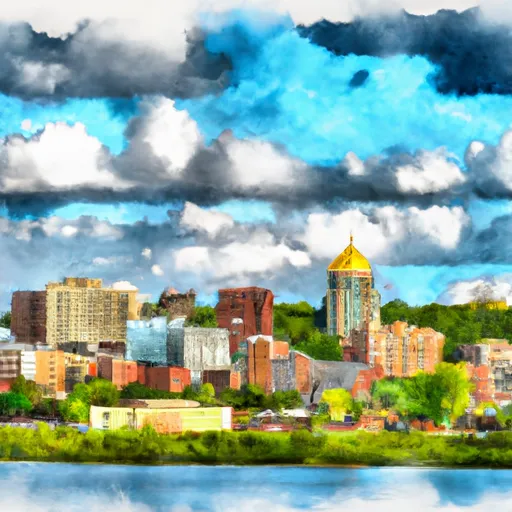-
 Snoflo Premium
Snoflo Premium
Get unlimited access to all our content
With no Ad interruptions! - Start Your Free Trial Login with existing account
Wabasha
Eden Index
Climate
6.7
•
Recreation
3.5
•
Community
3.6
•
Safeguard
4.8/10

Wabasha, Minnesota is a charming city located in Wabasha County, nestled along the Mississippi River. The climate in Wabasha is characterized by warm summers and cold winters. Summers are typically mild with average temperatures ranging from 70°F to 80°F, while winters can be quite chilly, with temperatures dropping below freezing. Precipitation is spread evenly throughout the year, with higher amounts in the summer months.
As for hydrology constituents, Wabasha benefits from its proximity to the Mississippi River. The river enhances the beauty of the area and provides various recreational opportunities. Fishing enthusiasts can enjoy angling for a variety of fish species such as walleye, bass, and catfish. Boating, kayaking, and canoeing are also popular activities on the river.
In addition to the river, Wabasha offers numerous outdoor recreation opportunities. The area is known for its picturesque landscapes, making it a haven for hiking and biking enthusiasts. Birdwatchers can explore the National Eagle Center, where they can observe and learn about bald eagles in their natural habitat. Wabasha also boasts several parks with amenities such as picnic areas, playgrounds, and sports fields, ensuring there is something for everyone to enjoy in the great outdoors.
What is the Eden Index?
The Snoflo Eden Index serves as a comprehensive rating system for regions, evaluating their desirability through a holistic assessment of climate health, outdoor recreation opportunities, and natural disaster risk, acknowledging the profound impact of these factors on livability and well-being.
Climate Health Indicator (CHI): 6.7
Wabasha receives approximately
858mm of rain per year,
with humidity levels near 83%
and air temperatures averaging around
8°C.
Wabasha has a plant hardyness factor of
4, meaning
plants and agriculture in this region thrive during a short period during spring and early summer. Most
plants will die off during the colder winter months.
By considering the ideal temperature range, reliable water supplies, clean air, and stable seasonal rain or snowpacks, the Climate Health Indicator (CHI) underscores the significance of a healthy climate as the foundation for quality living.
A healthy climate is paramount for ensuring a high quality of life and livability in a region, fostering both physical well-being and environmental harmony. This can be characterized by ideal temperatures, reliable access to water supplies, clean air, and consistent seasonal rain or snowpacks.
Weather Forecast
Streamflow Conditions
Upper Mississippi-Black-Root
Area Rivers
Upper Mississippi-Black-Root
Snowpack Depths
Upper Mississippi-Black-Root
Reservoir Storage Capacity
Upper Mississippi-Black-Root
Groundwater Levels
Recreational Opportunity Index (ROI): 3.5
The Recreational Opportunity Index (ROI) recognizes the value of outdoor recreational options, such as parks, hiking trails, camping sites, and fishing spots, while acknowledging that climate plays a pivotal role in ensuring the comfort and consistency of these experiences.
Access to outdoor recreational opportunities, encompassing activities such as parks, hiking, camping, and fishing, is crucial for overall well-being, and the climate plays a pivotal role in enabling and enhancing these experiences, ensuring that individuals can engage in nature-based activities comfortably and consistently.
Camping Areas
| Campground | Campsites | Reservations | Toilets | Showers | Elevation |
|---|---|---|---|---|---|
| Shelbina Lake City Park | None | 722 ft | |||
| Lakeview Park - Mexico | None | 810 ft | |||
| Pine Ridge | 8 | 770 ft | |||
| Austin County Park | None | 578 ft | |||
| Bentonsport | None | 561 ft | |||
| Sever Lake Conservation Area - MDC | 84 | 736 ft | |||
| Lacey - Keosauqua State Park | 113 | 744 ft | |||
| Lake Sugema County Park | None | 741 ft | |||
| Waubonsie Trail Park | 7 | 784 ft | |||
| Dry Fork | 18 | 763 ft |
Nearby Ski Areas
Catastrophe Safeguard Index (CSI):
The Catastrophe Safeguard Index (CSI) recognizes that natural disaster risk, encompassing floods, fires, hurricanes, and tornadoes, can drastically affect safety and the overall appeal of an area.
The level of natural disaster risk in a region significantly affects safety and the overall livability, with climate change amplifying these risks by potentially increasing the frequency and intensity of events like floods, fires, hurricanes, and tornadoes, thereby posing substantial challenges to community resilience and well-being.
Community Resilience Indicator (CRI): 3.6
The Community Resilience Indicator (CRI) recognizes that education, healthcare, and socioeconomics are crucial to the well-being of a region. The CRI acknowledges the profound impact of these elements on residents' overall quality of life. By evaluating educational resources, healthcare accessibility, and economic inclusivity, the index captures the essential aspects that contribute to a thriving community, fostering resident satisfaction, equity, and social cohesion.

